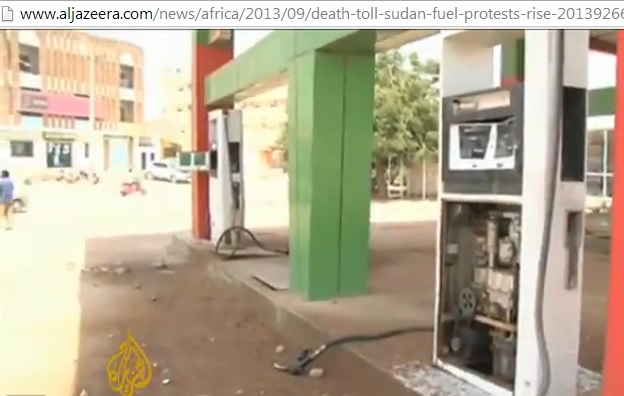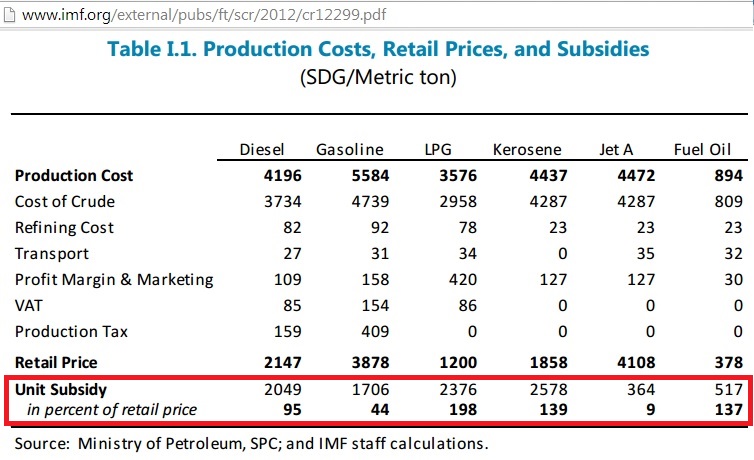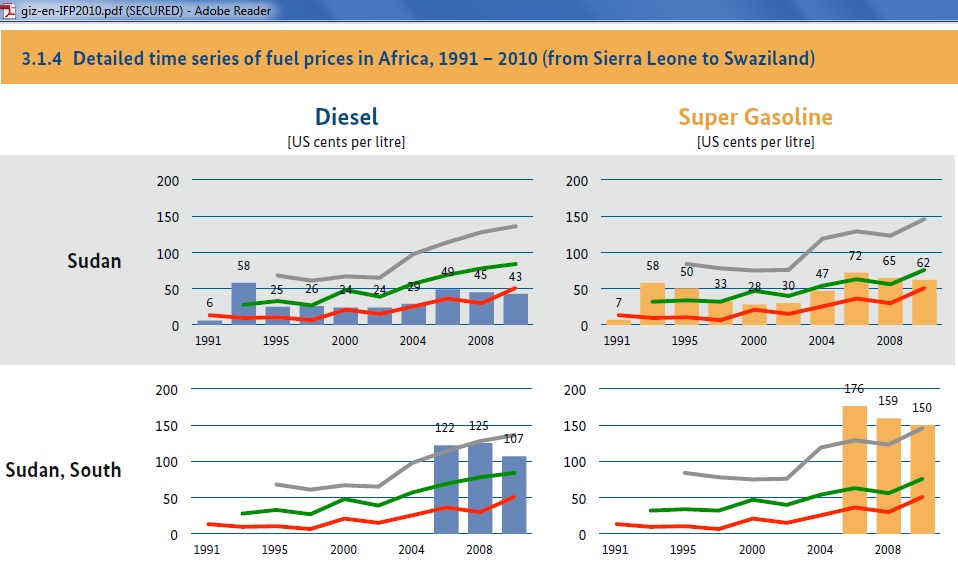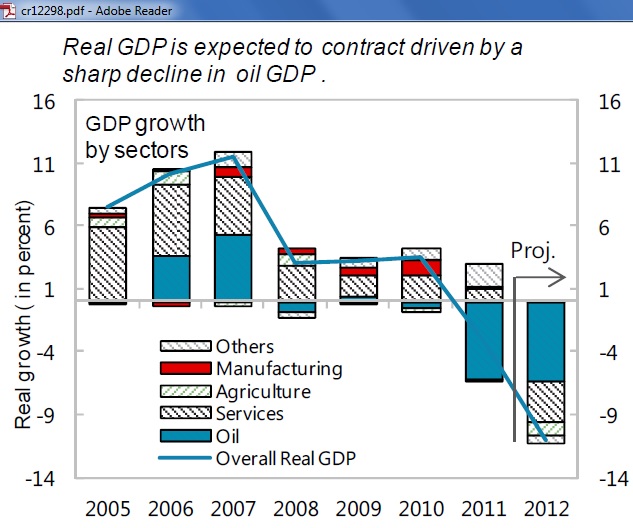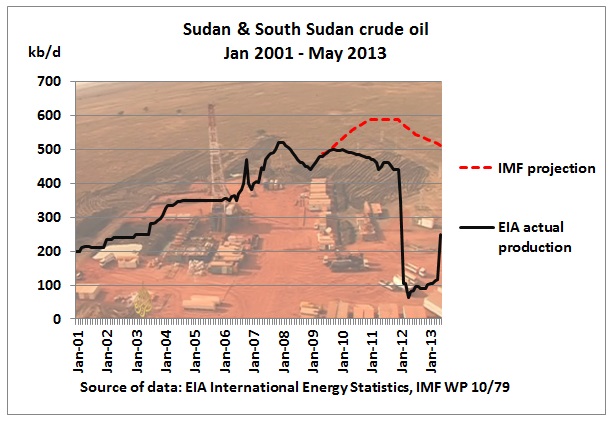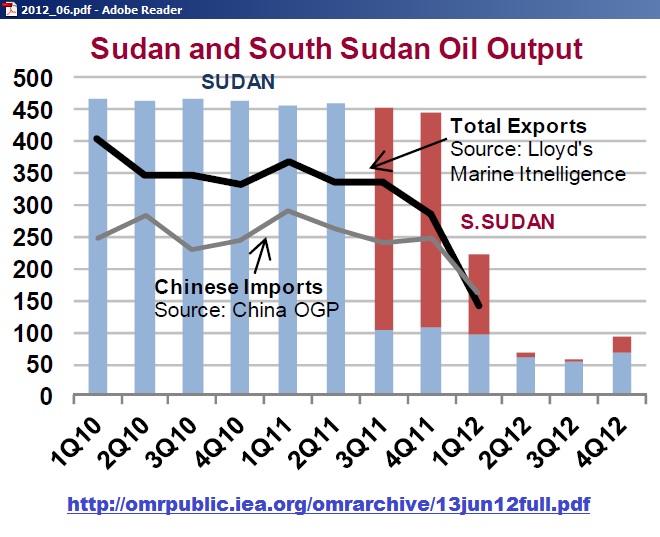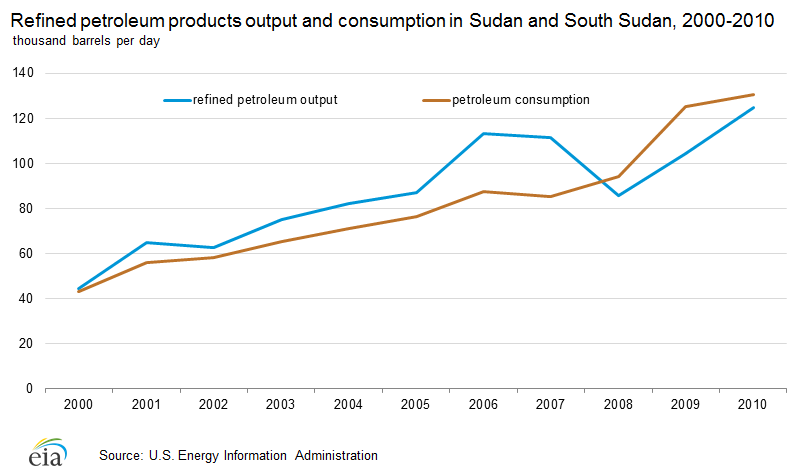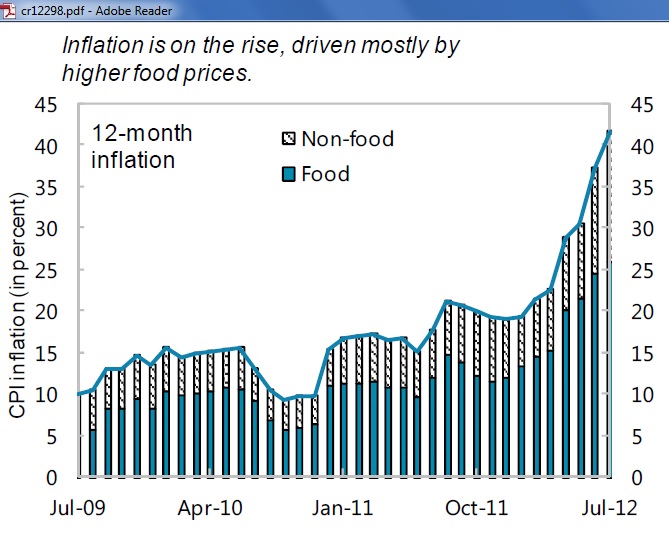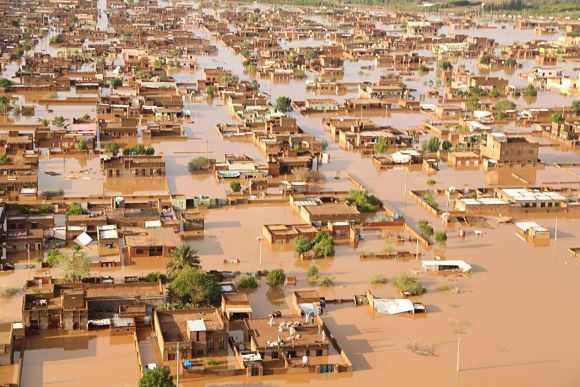As many oil producing countries, Sudan subsidizes petrol and diesel prices (compared to world market prices). But this has become unaffordable. What complicates matters is that South Sudan, where most of the oil is, became independent and fights continued over who owns the Abyei-Heglig oil fields and other border issues. Oil production dropped like a stone, just when it was peaking anyway.
The hard road to reduce fuel subsidies
Damaged petrol pump after fuel price protests
27/9/2013
The subsidy cuts come amid International Monetary Fund pressure on Sudan to curb spending and repay debts. Similar IMF-backed austerity measures announced last year also sparked protests that were quickly put down. Al-Bashir justified the new measures, saying they would rescue the country from collapse. A gallon (3.8 litres) of diesel increased from eight Sudanese pounds (£1.13) to 14 (£1.97) while a gallon of gasoline, once 12 SDG (£1.69), jumped to 21 (£2.96). http://www.theguardian.com/world/2013/sep/27/sudanese-protesters-attacked-march-fuel-subsidies 
World prices have not been passed through to the local market.
The IMF report 12/299 writes: Despite the June [2012] increase in fuel prices, subsidies remain high. This is mainly a result of the 66 percent devaluation of the exchange rate, which makes the cost of crude oil in local currency more expensive. Eliminating the subsidies—including the subsidy on purchases of crude oil by SPC—would require an average increase in retail prices of about 97 percent, (Table I.1), compared to 110 percent prior to the reform. To eliminate only the direct subsidy but not the tax subsidy, the required price increases would need to be 88 percent.
http://www.imf.org/external/pubs/ft/scr/2012/cr12299.pdf
.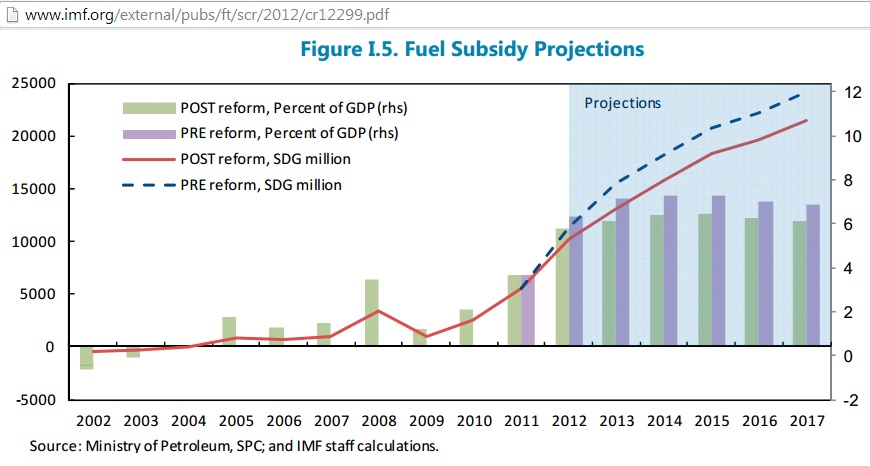 This graph shows the magnitude of the problem. Subsidies in 2012 were estimated at 5.2 % of GDP
This graph shows the magnitude of the problem. Subsidies in 2012 were estimated at 5.2 % of GDP
Comparison to neighbouring countries
The German agency for international cooperation GIZ has analysed fuel subsidies around the world (2010), including Africa:  .
.
This is an excerpt from the Africa map. Sudan has very high diesel subsidies (red, left box)
http://www.giz.de/Themen/en/29957.htm
http://www.giz.de/Themen/en/dokumente/giz-en-IFP2010.pdf
Grey benchmark line: retail price in Luxembourg, lowest in Europe
Green benchmark line: retail price in the US (non subsidised minimum with 10 cents for road funding)
Red benchmark line: crude oil price on world markets
Secession of South Sudan
The IMF in its Article IV consultation report of November 2012 (to be found here: http://www.imf.org/external/country/sdn/) assesses the impact of the secession of South Sudan as follows:
(1) Economy: Loss of output in oil sector 75%. In terms of value added loss this is 26% of GDP
(2) Fiscal sector: Revenue loss 6% of GDP
(3) Balance of payments: reduction in exports 13% of GDP
(4) Monetary sector: official reserves reduction by 17%
http://www.imf.org/external/pubs/cat/longres.aspx?sk=40081.0
The drop in GDP growth already started in 2008, when fights broke out in Abyei.
Crude production profile
According to a 2008 projection of the IMF in its working paper 10/79 (see previous post), Sudan’s oil production should have increased until 2011 to around 600 kb/d (peak production). But fights broke out in 2008 over Abyei’s oil and production dropped.
This graph from the IEA shows how oil production is split up between the North and South in 3Q2011 and 4Q2011 before collapsing. Exports to China have dropped. So this results in China looking for oil somewhere else, driving up oil prices.
Consumption
http://www.eia.gov/countries/cab.cfm?fips=SU Sudan has following refineries: Khartoum (50 kb/d Nile blend and 50 kb/d highly acidic Fula blend), Port Sudan (21.7 kb/d), El Obeid (10 kb/d), Shajirah (10 kb/d) and Gabra (2 kb/d). We can see that refinery output has dropped below increasing consumption. South Sudan plans a refinery in Bentiu (5 kb/d) and in the Upper Nile State (10 kb/d).
Impact of Global Warming
Another graph from the IMF report 12/298
One contributing factor to high food prices is global warming.
Sudan – battling the twin forces of civil war and climate change
21 Nov 2011
Water stress and a food security crisis looms in Sudan, where millions of hectares of semi-desert has turned into desert
A thousand miles south of Cairo, Sudan is having another rotten year. To the east, Somalia, much of Ethiopia and the Horn of Africa are experiencing their third or fourth drought in a decade. This one is the deepest in 60 years and has led to millions of people becoming destitute, vast migrations and loss of animals. Sudan has this year been experiencing similar, but less dramatic conditions, with unpredictable rains, late harvests and severe crop losses. Nearly 4m people will need food aid, the harvest next year is expected to be well below average, and farmers are fleeing intense fighting between north and South Sudan troops in the Blue Nile and South Kordofan provinces.
http://www.theguardian.com/environment/2011/nov/21/sudan-civil-war-climate-change
This year, Sudan experienced the other extreme, floods:
The deluge has taken a heavy toll. Beyond the dozens of people killed, more than 300,000 people have been directly affected, with 74,000 homes damaged or destroyed, according to the United Nations. The spread of diseases like malaria is also reported to be on the rise.
“We can attribute this to climate change,” said Nagmeldin Elhassan of the Higher Council for Environment and Natural Resources, a government agency.
Mr. Elhassan, who has contributed to reports by the IPCC, referred to studies that predicted what he called “incidents of frequent and intense droughts and incidents of high levels of rains” in the region and “shifts in rain patterns,” like later start dates of the rainy season.
Conclusion:
Given the slow increase in consumption and assuming the IMF production projection is correct it would take another 10 years until Sudan would become a net importer of oil – under normal circumstances . But as we can see, problems come much earlier, caused by fights over oil.
Previous post:
31/5/2011
Sudan’s Nile blend in decline – why we should be concerned
http://crudeoilpeak.info/sudan-nile-blend-in-decline-why-we-should-be-concerned
